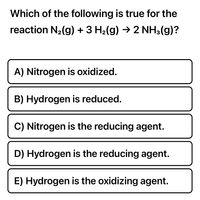
Chemistry
10th Edition
ISBN: 9781305957404
Author: Steven S. Zumdahl, Susan A. Zumdahl, Donald J. DeCoste
Publisher: Cengage Learning
expand_more
expand_more
format_list_bulleted
Question
thumb_up100%

Transcribed Image Text:Which of the following is true for the
reaction N2(g) + 3 H2(g) → 2 NH3(g)?
A) Nitrogen is oxidized.
B) Hydrogen is reduced.
C) Nitrogen is the reducing agent.
D) Hydrogen is the reducing agent.
E) Hydrogen is the oxidizing agent.
Expert Solution
This question has been solved!
Explore an expertly crafted, step-by-step solution for a thorough understanding of key concepts.
This is a popular solution
Trending nowThis is a popular solution!
Step by stepSolved in 3 steps

Knowledge Booster
Learn more about
Need a deep-dive on the concept behind this application? Look no further. Learn more about this topic, chemistry and related others by exploring similar questions and additional content below.Similar questions
- Use the References to access important values if needed for this question. 2Bi + HXeO4+ 3H2O- —Хе + 2Bi(ОН)з+ ОН In the above redox reaction, use oxidation numbers to identify the element oxidized, the element reduced, the oxidizing agent and the reducing agent. name of the element name of the element oxidized: reduced: formula of the formula of the oxidizing agent: reducing agent:arrow_forwardIn the following reaction, which element in what species is oxidized? C,H, (g) + 3 0, (g) → 2 CO, (g) + 2 H,0 (g)arrow_forward4Cr + 6NO2- + 9H204Cr(OH)3 + 3N2O+ 6OH- In the above redox reaction, use oxidation numbers to identify the element oxidized, the element reduced, the oxidizing agent and the reducing agent. name of the element oxidized: fill in the blank 1 name of the element reduced: fill in the blank 2 formula of the oxidizing agent: formula of the reducing agent:arrow_forward
- For the redox reaction given below complete the following: ClO3¯ + SO2 → SO42¯ + Cl¯ (a) What is the oxidation no. of Cl in ClO3¯? (b) What is the oxidation no. of S in SO42¯ (c) Find the element oxidized (d) Find the element Reduced (e) Find the Oxidizing Agent (f) Find the Reducing Agentarrow_forwardSO42- + Pb+ 4H+Pb2+ + SO2+ 2H2O In the above redox reaction, use oxidation numbers to identify the element oxidized, the element reduced, the oxidizing agent and the reducing agent. name of the element oxidized: fill in the blank 1 name of the element reduced: fill in the blank 2 formula of the oxidizing agent: formula of the reducing agent:arrow_forwardThe oxidation number of Mn in MnO₂ isarrow_forward
- Complete (IF NECESSARY) and balance the following equations, then use oxidation numbers to explain if each of the following reactions is a redox reaction. If the reaction is redox, identify the element being oxidized, the element being reduced, oxidizing agent, and reducing agent. (c) NH3 (g) + NO2 (g) --> N2 (g) + H2O (l)arrow_forwardThe oxidation number of the chlorine atom in ClO₂ isarrow_forwardIn the above redox reaction, use oxidation numbers to identify the element oxidized, the element reduced, the oxidizing agent and the reducing agent.arrow_forward
- the oxidation number of a nitrogen atom in N2O3 isarrow_forwardFor the reaction: Br2 + ClO– → Br– + ClO3– Which species is oxidized? ClO– Br2 ClO3– Which species is the oxidizing agent? ClO– Br2 Br–arrow_forward6) For the following redox reaction: Fe203(s) + 3 СО(g) — 2 Fe(s) + 3 СOО:(g) a) What is the oxidation number of each atom in the reactants? Fe C O (from Fe2O3) O (from CO) b) Which atom gets oxidized? Which atom gets reduced? Which species is the oxidizing agent? Atom oxidized Atom reduced Oxidizing agent Reducing agentarrow_forward
arrow_back_ios
SEE MORE QUESTIONS
arrow_forward_ios
Recommended textbooks for you
 ChemistryChemistryISBN:9781305957404Author:Steven S. Zumdahl, Susan A. Zumdahl, Donald J. DeCostePublisher:Cengage Learning
ChemistryChemistryISBN:9781305957404Author:Steven S. Zumdahl, Susan A. Zumdahl, Donald J. DeCostePublisher:Cengage Learning ChemistryChemistryISBN:9781259911156Author:Raymond Chang Dr., Jason Overby ProfessorPublisher:McGraw-Hill Education
ChemistryChemistryISBN:9781259911156Author:Raymond Chang Dr., Jason Overby ProfessorPublisher:McGraw-Hill Education Principles of Instrumental AnalysisChemistryISBN:9781305577213Author:Douglas A. Skoog, F. James Holler, Stanley R. CrouchPublisher:Cengage Learning
Principles of Instrumental AnalysisChemistryISBN:9781305577213Author:Douglas A. Skoog, F. James Holler, Stanley R. CrouchPublisher:Cengage Learning Organic ChemistryChemistryISBN:9780078021558Author:Janice Gorzynski Smith Dr.Publisher:McGraw-Hill Education
Organic ChemistryChemistryISBN:9780078021558Author:Janice Gorzynski Smith Dr.Publisher:McGraw-Hill Education Chemistry: Principles and ReactionsChemistryISBN:9781305079373Author:William L. Masterton, Cecile N. HurleyPublisher:Cengage Learning
Chemistry: Principles and ReactionsChemistryISBN:9781305079373Author:William L. Masterton, Cecile N. HurleyPublisher:Cengage Learning Elementary Principles of Chemical Processes, Bind...ChemistryISBN:9781118431221Author:Richard M. Felder, Ronald W. Rousseau, Lisa G. BullardPublisher:WILEY
Elementary Principles of Chemical Processes, Bind...ChemistryISBN:9781118431221Author:Richard M. Felder, Ronald W. Rousseau, Lisa G. BullardPublisher:WILEY

Chemistry
Chemistry
ISBN:9781305957404
Author:Steven S. Zumdahl, Susan A. Zumdahl, Donald J. DeCoste
Publisher:Cengage Learning

Chemistry
Chemistry
ISBN:9781259911156
Author:Raymond Chang Dr., Jason Overby Professor
Publisher:McGraw-Hill Education

Principles of Instrumental Analysis
Chemistry
ISBN:9781305577213
Author:Douglas A. Skoog, F. James Holler, Stanley R. Crouch
Publisher:Cengage Learning

Organic Chemistry
Chemistry
ISBN:9780078021558
Author:Janice Gorzynski Smith Dr.
Publisher:McGraw-Hill Education

Chemistry: Principles and Reactions
Chemistry
ISBN:9781305079373
Author:William L. Masterton, Cecile N. Hurley
Publisher:Cengage Learning

Elementary Principles of Chemical Processes, Bind...
Chemistry
ISBN:9781118431221
Author:Richard M. Felder, Ronald W. Rousseau, Lisa G. Bullard
Publisher:WILEY